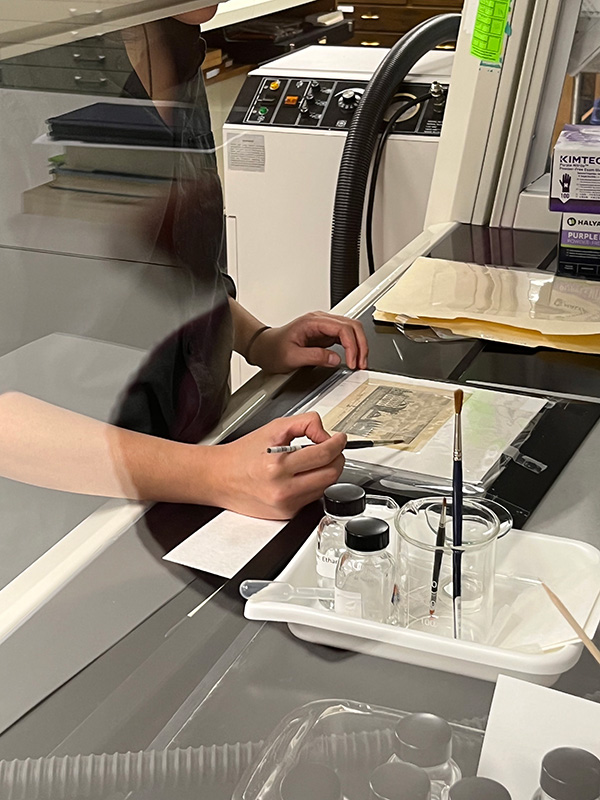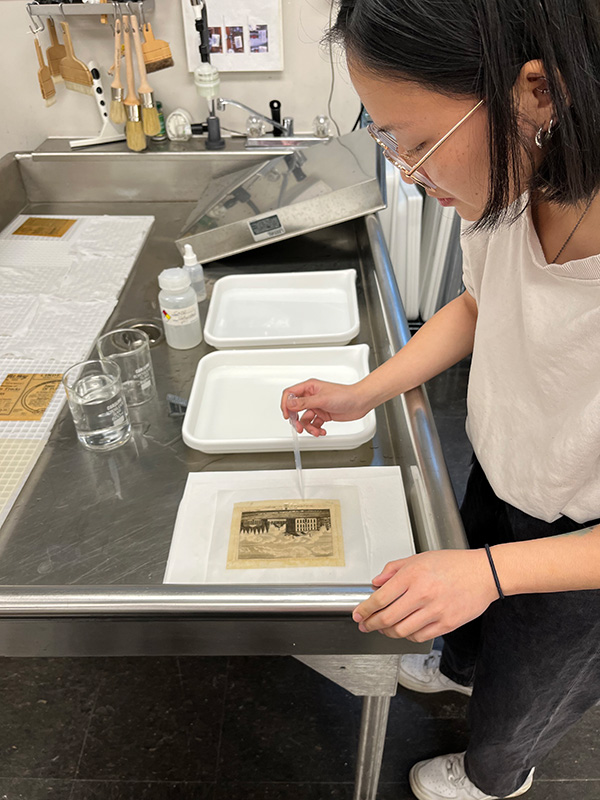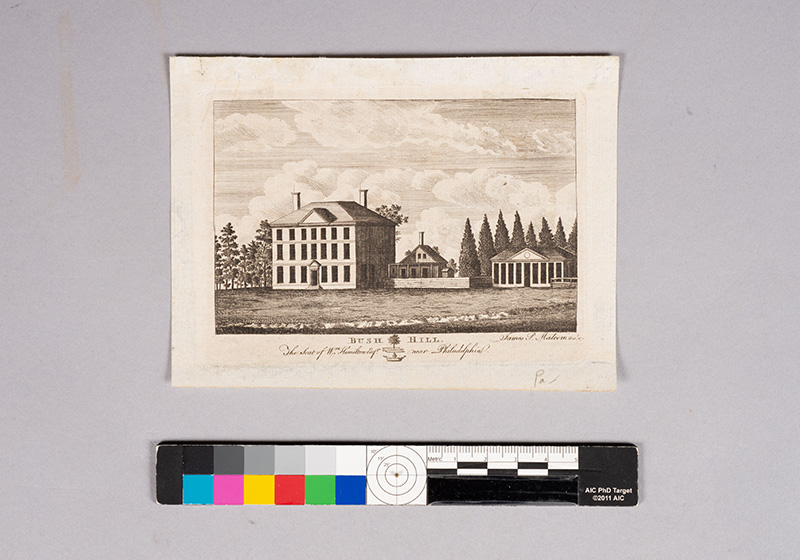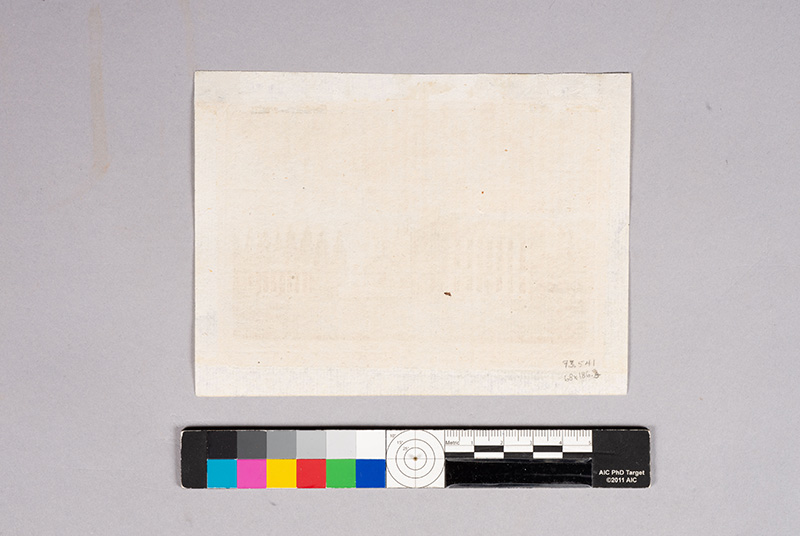The Conservation Treatment of a Print Depicting Philadelphia’s Bush Hill Estate from the Winterthur Museum
by Tammy Hong
The interdisciplinary aspects that drive decision-making in art conservation are often described as a three-legged stool. As a second year Graduate Fellow in the Winterthur/University of Delaware Program in Art Conservation (WUDPAC), I use the legs of the stool—my knowledge and training in science, research, and studio art—when caring for artifacts that come across my work bench. This approach allows me to develop a treatment plan that supports the cultural stakeholders associated with the artifacts and considers the resources available at hand. My treatment of Winterthur Museum’s intaglio print (figures 1 and 2) depicting the Bush Hill Estate in Philadelphia illustrates the process.
Bush Hill was a well-recognized landmark in Philadelphia during the 18th and 19th centuries. The house sat on 140 acres of land that stretches between the city’s present-day 12th and 19th Streets (east-west) and Fairmount Avenue to Vine Street (north-south), property once owned by the Penn family.1 The manor house was built in 1737 for Andrew Hamilton (1676–1741), a Scottish-born lawyer and confidante of William Penn (1679–1720), the founder of the Province of Pennsylvania. Penn’s family gave the land to Hamilton as payment for settling his estate. The manor was briefly the home to President John Adams (1735–1826) when Philadelphia served as the temporary Capital of the United States in the 1790s.2 The house was also appropriated by the city of Philadelphia for use as a temporary hospital to treat and isolate victims of the yellow fever outbreak in 1793.3 The residence was unoccupied at this time as William Hamilton (1745–1813), James Hamilton’s nephew, demonstrated very little interest in the Bush Hill property, choosing to build The Woodlands as his primary country retreat. In the 1800s, much of the Bush Hill Estate was sold off by Hamilton’s heirs, who then converted the residence into a tavern and a resort. The mansion was demolished in 1875.4
The intaglio print is a historical record of the Bush Hill Estate and serves as an important reminder of a portion of Philadelphia’s 18th-century history that no longer exists. I kept this historical significance in mind as I examined the condition of the print to develop a treatment plan. The purpose of the treatment was to improve the contrast between the paper substrate and the print image while improving the strength and longevity of the print to support future display and access to this gateway into Philadelphia’s history. These goals were achieved by removing the pressure sensitive tapes and linen hinges attached to the back of the print, addressing the staining of the print image’s margins by extracting and reducing the impregnated adhesive residues in those areas, and removing surface grime and overall discoloration of the paper substrate.
Prior to performing the conservation treatment, the solubility and friability of the print media was tested to determine the media’s sensitivity to dry and aqueous applications. The print was then selectively surface cleaned with soft brushes, vinyl erasers, and cosmetic sponges to remove accumulated dust and grime. The pressure sensitive tapes and linen hinges on the back of the print were removed using a combination of deionized water, acetone, and mechanical action via a heated spatula. Solvent testing was then conducted using the adhesive residues collected from the tapes to determine the most effective solvent mixture for addressing the impregnated adhesives in the print’s margins. After testing, the staining in the print’s margins was reduced using a solution consisting of 3mL benzyl alcohol, 10mL deionized water, 10mL ethanol, and 10mL acetone on a suction table in the fume hood (figure 3). The overall discoloration of the substrate was reduced by bathing the print in a dilute alkaline hypotonic calcium hydroxide and deionized water solution. The print was submerged for 30 minutes in the first bath and then moved onto a blotter. Ammonia water was delivered via a pipette (figure 4) to the margins of the print to flush out the impregnated adhesives before resubmerging in a second bath for another 30 minutes. The print was removed from the bath to be flattened between felts and under weights to dry for a week.
Figure 3. A solution consisting of 3mL benzyl alcohol, 10mL deionized water, 10mL ethanol, and 10mL acetone was delivered via a soft brush on a suction table in the fume hood to address the staining in the print’s margins. Photo by Joan Irving.
The contrast between the paper substrate and the print image of the Bush Hill Estate as well as the strength of the substrate noticeably improved after treatment (figures 5 and 6). The care of the print driven by an interdisciplinary approach combining chemistry, historical research, and careful treatment execution was documented and photographically recorded.
These documents will continue to provide the print with context and support future researcher access to the cultural dialogues associated with the Bush Hill Estate and the history of Philadelphia in the 1700s.
- Cornfield, Dennis B. “The Hospital at Bush Hill: Philadelphia’s Response to the 1793 Yellow Fever Pandemic.” MD Advisor 2020, MD Advantage. Accessed September 23, 2022. https://www.mdadvantageonline.com/feature-articles/the-hospital-at-bush-hill-philadelphias-response-to-the-1793-yellow-fever-epidemic/
- Free Library of Philadelphia. “Hamilton Residence. 18th & Hamilton Street.” Digital Collections, Free Library of Philadelphia. Accessed September 23, 2022. https://libwww.freelibrary.org/digital/item/40517
- The History Engine. “Yellow Fever Attacks Philadelphia, 1793.” The History Engine, Digital Scholarship Lab. Accessed September 23, 2022. https://historyengine.richmond.edu/episodes/view/5282
- Meredith, Mark. “BUSH HILL. Philadelphia, Pennsylvania.” House Histree. Last modified on July 3, 2021. https://househistree.com/houses/bush-hill
Tammy Hong is the National Endowment for the Humanities Graduate Fellow, Class of 2024. She received a Continuing Education Scholarship to attend Historic Deerfield’s Summer Fellowship program in 2018, which was described in the winter 2018–19 issue of The Magazine of the Decorative Arts Trust and a lecture during the 2019 Emerging Scholars Colloquium.
About The Decorative Arts Trust Bulletin
Formerly known as the "blog,” the Bulletin features new research and scholarship, travelogues, book reviews, and museum and gallery exhibitions. The Bulletin complements The Magazine of the Decorative Arts Trust, our biannual members publication.
Click Images to Enlarge
Did you know that clicking on the images in Bulletin posts will allow you to get a closer look? Simply click on an image, and a larger version will open in a pop-up window.













